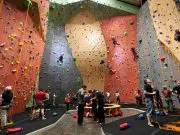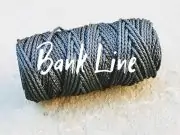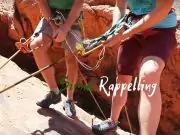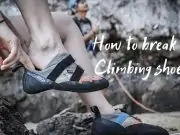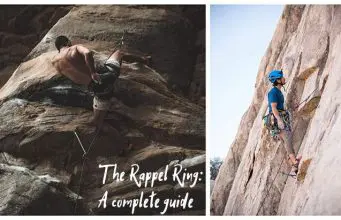Today I wanted to focus on a specific example of climbing slang: the Ape Index. Not only is this term incredibly popular but understanding it can help you identify your strengths and limitations when it comes to climbing and other similar activities.
So what is the Ape Index and how do you measure it? It’s quite simple really: the Ape Index represents the ratio of your arm span in relation to your height. In order to calculate it, you first need to measure both, and then you can go about it in two ways: either subtract your height from your wingspan or divide your wingspan by your height.
Let’s have a look at each of these methods separately and see what kind of results you can expect to obtain. I’ll use my own measurements as examples, and you can simply swap mine for yours in order to obtain a personalized result.
Method 1: Subtracting height from wingspan.
The actual formula: Wingspan – Height.
As an example, Ava is 5 foot 5 (66 inches or 167.6 cm) and has a wingspan of 68 inches. With this data, we can subtract the height from the wingspan in order to obtain the correct result.
We’d have to use the inch value for height in order to do this right. By subtracting the height (66 inches) from the wingspan (68 inches), we obtain an ape index of 2 inches.
We can also use centimeters to do this, in which case we would subtract 167.6 from 172.7 and get an ape index of 5.1cm.
It’s worth noting that most people have the same arm span as their height. In this case, the result of the formula will be 0 no matter what format you use for your measurements (inches or cm). However, if your wingspan is not the same as your height, the numbers will differ depending on what measurement unit you use. Our example above is proof of this. Still, this is the most common method used by climbers to measure their ape index, as it clearly shows the difference between the arm span and the height.
Method 2: Revealing the wingspan to height ratio.
The second method yields a ratio between the climber’s wingspan and height, and while it’s not as popular as the first method, it’s still relatively easy to implement.
The actual formula: Wingspan/Height.
Ava is 5 foot 5 (66 inches or 167.6cm) and her wingspan is 68 inches. To reveal her ape index ratio, we’ll need to divide her wingspan by her height.
68 inches divided by 66 inches = 1.03.
Ava has an ape index ratio of 1.03. She has slightly more wingspan than height and this is reflected in the ratio, which is above 1. Most climbers have a flat 1 ratio, meaning their wingspan and height are equal. If we were to use centimeters instead of inches with this method, the result would remain the same. That’s the main advantage of method 2.
What are the ape indexes of famous climbers?
I also wanted to show you the actual ape index values of some of the world’s most famous climbers, so that you might compare them to your own. It appears that a positive ape index (wingspan larger than height) is often correlated with improved climbing performance, but that’s not necessarily always the case. We’ll talk about the advantages of a positive ape index a bit later in this article.
If we’re talking extremes, the largest ape index ratio that I’ve heard of is Kai Lightner’s, who has a ratio of 1.09 or a difference of +7.0 between his wingspan and height. Kai is 75 inches tall and has an arm span of 82 inches.
On the opposite end of the spectrum, Babsi Zangerl, arguably the best female climber in the world, has a wingspan of 63 inches and a height of 63.8, which means that she has a negative ape index of -0.8 or a ratio of 0.99.
Furthermore, both Hazel Findlay and Alex Megos have ape index ratios of 1, meaning their height is equal to their wingspan. More often than not, though, the world’s most famous climbers have longer arms, and it’s not hard to figure out why this would be an advantage. Let’s analyze this in more detail.
Is it better to have a positive ape index as a climber?
Simply put, if you were to measure the performance of two climbers of equal height, but with different ape index ratios, the one with the positive ape index should theoretically be the better climber. The reason for this is simple: even though the two climbers have the same height, the one with the positive ape index has more reach and would be able to climb more efficiently.
It’s also true that there’s no way you can influence your ape index. There’s no training regimen that would help you improve this. You could improve your overall flexibility, and this might improve your reach, but that’s assuming you were in bad shape to begin with. A pro climber who is already training rigorously and is in peak shape would have no way of improving his ape index. That being said, there are other things that you can do to enhance your performance.
These trainable factors include your overall fitness level, the percentage of body fat, and your overall grip strength in relation to your body mass. Not too long ago, I wrote an article about grip trainers and whether they actually give any benefits or not. I also touched on some conventional grip training methods involving buckets of rice. The truth is that improving your grip and lowering your body fat percentage can make you a better climber, and you can control these factors directly.
It takes a lot of work, but the reward is worthwhile.
Let’s have a look at the statistics.
The ape index, otherwise known as the gorilla index or ape factor, is officially an untrainable variable in several studies that focused on the effect of physiological factors in rock-climbing ability. As I mentioned before, the results were largely mixed.
Some studies have found that untrainable factors were not necessarily correlated with an improvement in climbing ability. In addition, one study even labeled the ape factor as irrelevant, but the author later clarified that this was simply because of the low variability between the climbers.
On the other hand, a 2001 study focused on comparing the performances of teenage male climbers vs female climbers. The differences in performance were explained using several factors, one of which was the lower ape index of the female climbers.
Is the ape index important in other sports?
I did some research and it looks like having longer arms in relation to your height can constitute a clear advantage in other sports, even more so than in climbing.
- In swimming, having longer arms can result in improved performance, and a great example of this is Michael Phelps, who boasts an arm span that is 10cm (3.9 inches) greater than his height.
- In boxing, more reach means you can hit your opponent while keeping your distance. More often than not, we’ve seen boxers with shorter arms struggle to close the distance between them and the opponent. A great example of a boxer with an impressive gorilla index is none other than Conor McGregor.
- Goalkeepers with higher indexes will be better at their job when compared to those who have shorter arms.
- In basketball, a positive ape index makes it easier to intercept shots and contest passes, thus making the player naturally better at defense.
Conclusion.
As you can see, having longer arms in relation to your body height can offer an advantage in certain sports, climbing included. If you have a positive ape index and you’re really passionate about climbing, you can consider yourself quite lucky.
Now that you know the formulae to measure your own ape factor, go ahead and try it out for yourself. I hope that this guide has been useful to you and that you now have a better understanding of the concept, how to measure it, and what it stands for.


